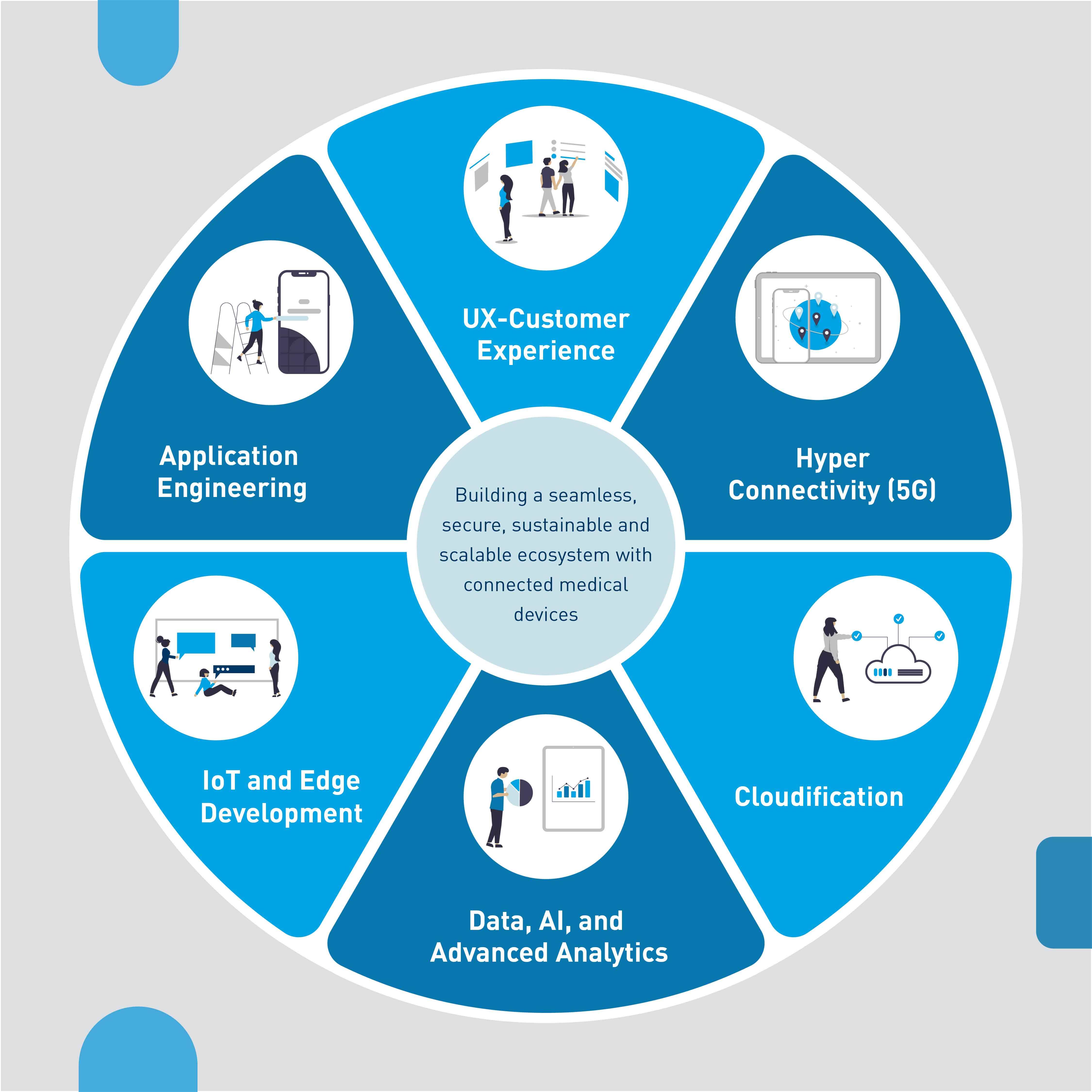With connectivity at the core of this new reality, medical devices are playing an expanding role in healthcare transformation. Secured, connected medical devices currently constitute around 30% of the global data volume, bringing in the opportunity for better clinical outcomes for patients and providers. Innovative surgical interventions, groundbreaking assistive care and therapy services, robust drug delivery and patient monitoring solutions, and intelligent diagnosis and imaging are poised to disrupt the medical devices sector.
However, the industry is yet to unlock the potential of this massive data volume generated through the Internet of Medical Things (IoMT) to drive personalized and connected patient experiences while also improving outcomes and reducing costs. Standing at the cusp of a secured connectivity-driven revolution, MedTech companies are still struggling to get IoMT right from a business perspective to deliver more value to healthcare.
That said, healthcare reforms and technological advances are converging and, together, driving the demand for a new generation of innovative connected medical devices. In doing so, the majority of enterprises have started to invest in connectivity enablement of medical devices in one or multiple product offerings in post-care and pre-care scenarios across the care continuum. Moreover, many enterprises are focusing on launching new connectivity-embedded medical devices rather than retrofitting their legacy medical devices. The existing drug delivery monitoring and diagnostic equipment are being amplified and enriched with features using edge intelligence and cloud connectivity. Besides, technologies like big-data analysis based on machine learning, AI, and cloud infrastructures are significantly fueling this transformation. The industry is also witnessing a sharp investment increase in innovative use cases such as smart inhalers and remote monitoring mobile applications, along with co-innovation in the connected medical devices space through strategic partnerships with service providers.
Gearing up for prime time
Mapping a path towards a connected care system, a majority of MedTechs are in the middle of the implementation spectrum for connected medical devices. The recent industry and consumer trends have catalyzed connected medical device adoption, pushing the envelope in healthcare. Enterprises are setting and pursuing tangible goals while also weighing the common challenges before embarking on the journey toward a connected care system. For starters, MedTechs are focused on meeting cybersecurity and regulatory compliance requirements that tend to create obstacles on the way to adoption. The key to solving these cybersecurity and regulatory compliance issues that stem from data exchange between connected devices lies in building a connected ecosystem (complying with interoperability HL7 FHIR standards) that ensures robust interoperability by linking devices across the care continuum.
A step ahead of the disruption with HARMAN
Technology innovation at an unprecedented pace is in HARMAN's DNA. We are continuing this innovation streak by building connected devices and IoMT ecosystems powered by connectivity, edge analytics, predictive models, and sustainable serviceability. HARMAN augments niche product engineering capabilities to support MedTechs in scaling their connected care efforts. We help MedTechs design highly interoperable smart health devices that can seamlessly transmit patient-generated data to the cloud and integrate with third-party applications.
Excelling in the connectivity-fueled era
With the adoption of IoT-powered medical devices booming worldwide, companies like Philips Healthcare and GE Healthcare are transforming healthcare with innovative equipment, imaging, and digital offerings. GE Healthcare offers IoT-enabled devices specifically built for patient monitoring, respiratory care, diagnostic imaging, and anesthesia systems. On the other hand, Philips' IoT products for healthcare include patient monitors, respiratory care devices, ventilators, imaging systems, vital signs monitoring devices, and more. At the core, product uptime, focusing on providing optimal patient care, serves as a competitive advantage and key to success for companies in this market.
Recognized as a Major Contender in Everest Group’s Connected Medical Device Services PEAK Matrix® Assessment, 2022, HARMAN is committed to scripting innovative success stories for its customers. Putting theory into practice, HARMAN is setting a benchmark in the industry in partnership with some of the world's leading healthcare companies to enable their digital transformation journey. Here's a glimpse of the innovation HARMAN is stirring in the connected medical devices space.
● IoT-based condition-based monitoring platform driving product uptime and availability
● Edge analytics-powered, E2E solution for early detection of problems and rotating equipment for analysis of abnormal vibration patterns
● Health monitoring of lab equipment for measuring KPIs like CO2, O2, temperature, humidity, and other factors
● Immersive experience for product training and feature highlights
● A globally-leading neonatal diagnostic breath analyzer – an e2e device with FDA 510K certification and complex algorithms
● FDA-registered Class 1 medical device – virtual reality glasses for vision-impaired patients
Cloudification using AWS
HARMAN is helping health solution providers, clinical research organizations, device OEMS and service providers using AWS services like AWS HealthLake, Amazon Comprehend Medical, SageMaker, Amazon S3 and other cloud services to build data analytics and personalized healthcare. We are also helping healthcare customers to migrate their private cloud to AWS using tools developed inhouse.
The time to act is NOW
Healthcare stands at a unique precipice in time. With IoMT taking centerstage, connected medical devices hold the potential to usher in diagnostic benefits and improve patient outcomes while opening new avenues for automation, real-time remote monitoring, and significantly reduced costs. Building data monetization by tweaking business models and developing new revenue streams. The medical device industry is poised to witness a CAGR of over 5 percent and is predicted to reach nearly $800 billion by 2030. This market penetration translates to improved ways of generating, collecting, storing, analyzing, and sharing valuable healthcare data.
First movers are enabling advanced capabilities in connected health to strengthen their bonds with patients and other stakeholders and create barriers to switching. The wait-and-see approach will make it difficult for slow movers to catch up in this fast-moving space.
For more information on healthcare connectivity with IoMT, talk to a HARMAN expert here.
